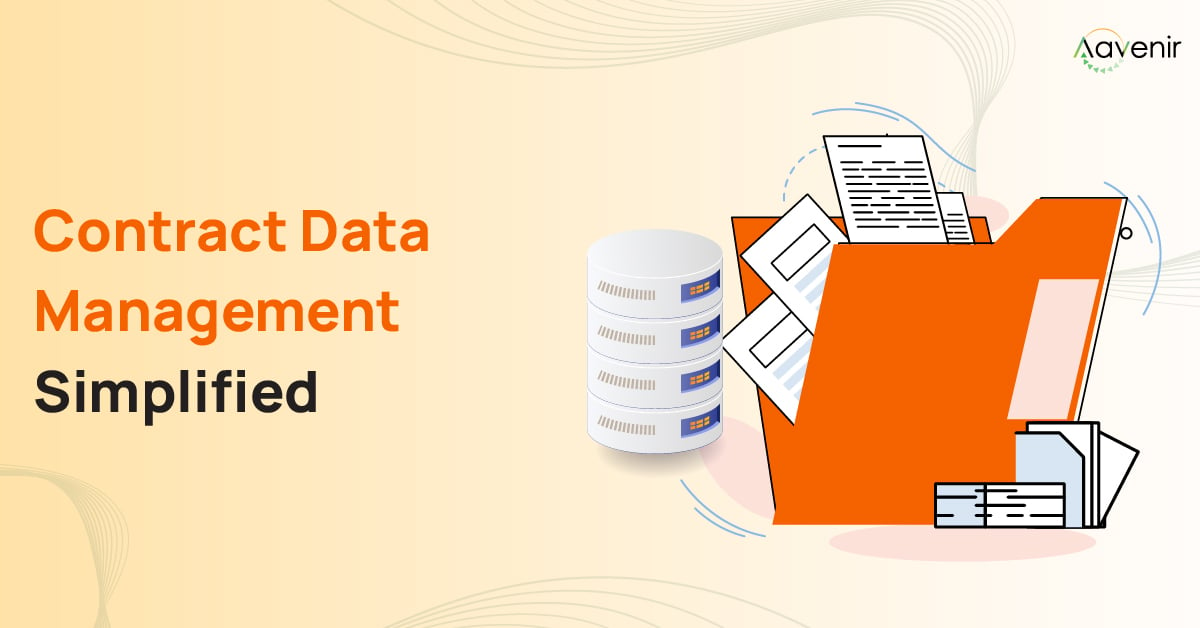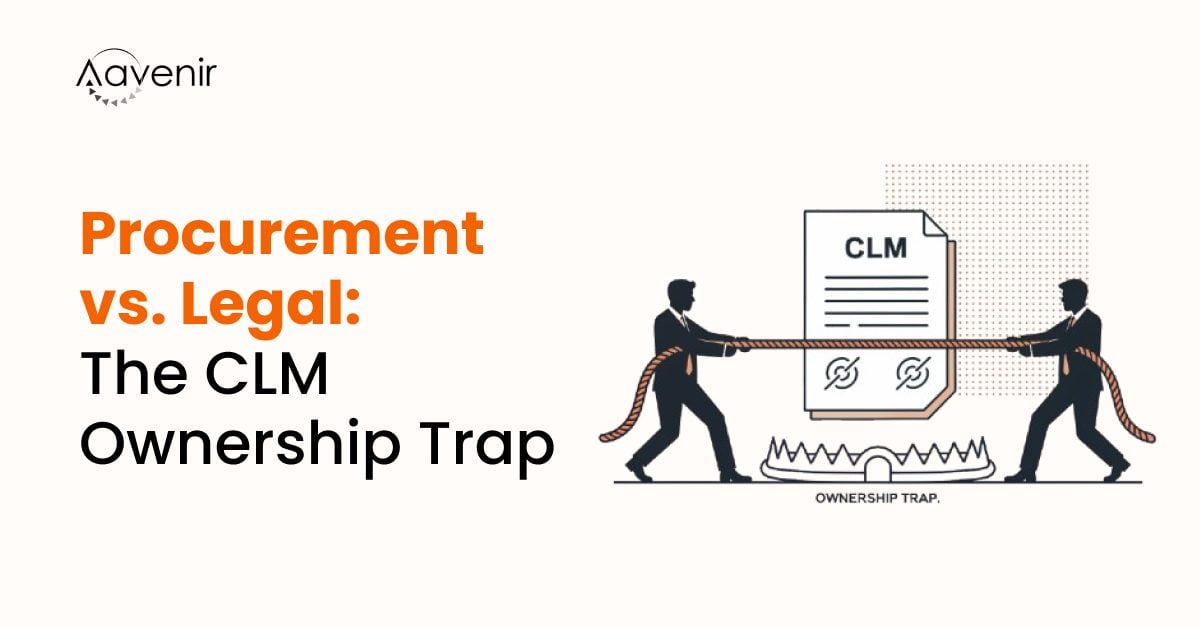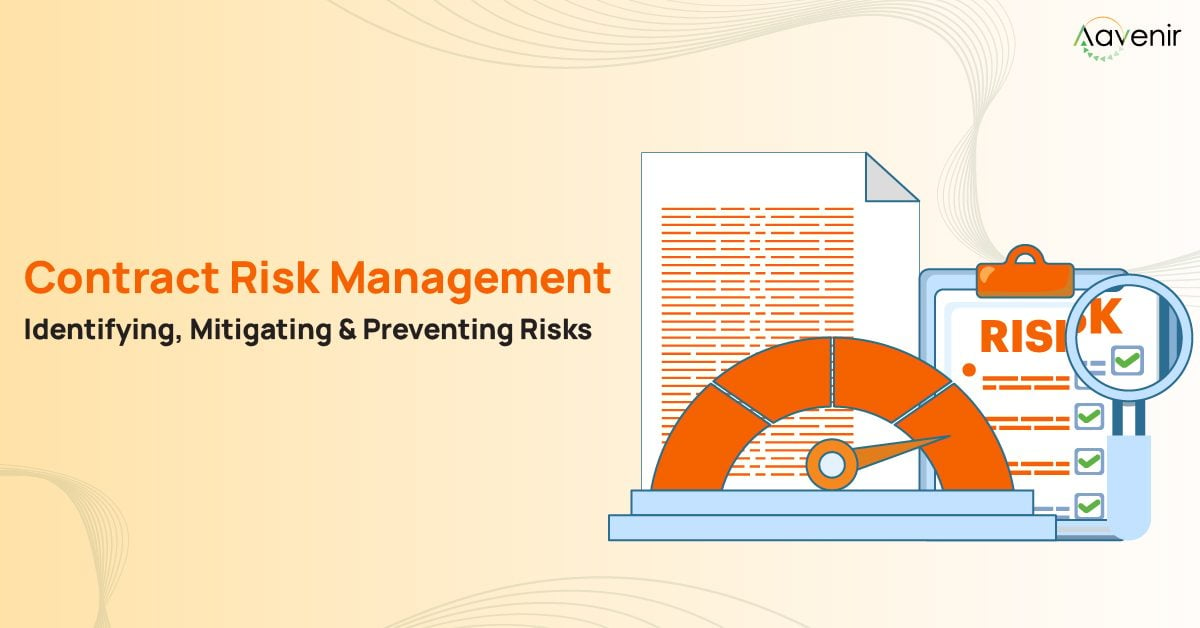Managing contracts is one thing, and managing the data within contracts is another challenge entirely.
If you’re dealing with hundreds (or thousands) of contracts across departments, you’ve probably faced issues like:
- Wasting hours trying to locate key dates, clauses, or obligations
- Missing renewals or compliance checks due to siloed or unstructured data
- Struggling to track performance or risk because your contract data isn’t centralized
If these challenges sound familiar, you’re not alone. Many legal, procurement, and finance teams face the same problems, and the solution lies in how you manage your contract data.
In this blog, we’ll break down what contract data management really means, why it matters, the different types of contract data you should track, and how to manage it efficiently with the help of automation and CLM software. Let’s get started.
What Is Contract Data Management?
Contract data management is the process of capturing, organizing, storing, and analyzing critical information found within agreements. Instead of treating contracts as static documents, businesses extract key data points—such as renewal dates, payment terms, obligations, and contract compliance requirements—to manage them proactively throughout the contract lifecycle.
Responsibility for managing contract data typically spans multiple teams, including:
- Legal: Ensures contract terms, obligations, and compliance requirements are accurately captured and monitored to minimize legal risks.
- Procurement: Tracks vendor obligations, service levels, and contract milestones to manage supplier relationships and control costs.
- Sales: Monitors customer contract terms, renewals, and deliverables to drive revenue growth and manage client expectations.
- Finance: Oversees payment schedules, financial commitments, and penalties within contracts to safeguard cash flow and financial reporting accuracy.
- Compliance: Reviews regulatory clauses, risk factors, and reporting requirements to ensure the organization meets legal and industry standards.
By ensuring contract data accessibility, businesses can make faster decisions, improve audit readiness, and enhance overall operational efficiency.
In the next section, we’ll explore the different types of contract data businesses should actively track to maximize the value and minimize the risks hidden inside their agreements.
5 Essential Types of Contract Data You Should Track
Contracts contain various types of structured data—from key dates and financial terms to compliance obligations and risk indicators. Here are the 5 key types of contract data you should track:
| Contract Data Types | Definition | Examples |
|---|---|---|
| Meta Data | High-level details about the contract that help organize and track it. |
|
| Financial Data | Payment terms and financial obligations outlined in the contract. |
|
| Obligation Data | Responsibilities and deliverables assigned to each party in the contract. |
|
| Risk and Compliance Data | Clauses related to legal, regulatory, and risk management requirements. |
|
| Renewal and Termination Data | Information on how and when a contract can be renewed or terminated. |
|
Now that you know which contract data to track, let’s understand why tracking data is useful for your business.
Why Is It Important To Manage Contract Data?
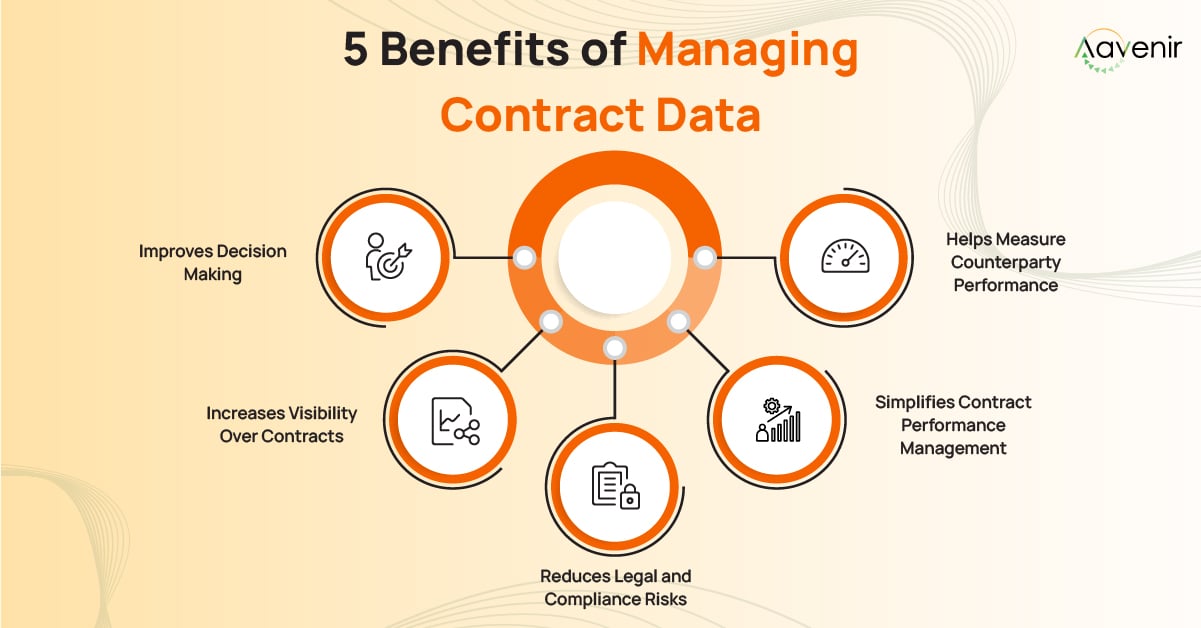
Tracking contract data streamlines contract management, improves decision-making, and reduces operational risks. Here are the key benefits of proactively monitoring and managing contract data:
1. Improves Decision Making
When contract information is scattered across emails, shared drives, and spreadsheets, decision-makers lack quick access to essential contract data, such as terms, obligations, and risks. This delays important business actions and can lead to missed opportunities or costly mistakes.
Centralized contract data management ensures that accurate, up-to-date information is readily available whenever needed. Leaders can quickly analyze payment terms, renewal timelines, obligations, and risk factors, enabling faster, more confident business decisions.
2. Increases Visibility Over Contracts
Without structured contract data, organizations often lose sight of contract statuses, upcoming deadlines, obligations, and key performance indicators. This limited visibility can cause compliance gaps, missed contract renewals, and inefficient contract management.
By organizing contract data systematically, teams gain complete visibility into active, expired, or pending contracts. Dashboards like those of Aavenir Contractflow help stakeholders track milestones, spot risks early, and plan better across procurement, sales, finance, and legal functions.
Get 5X Better Visibility Over Contracts
Monitor every contract in one place with Aavenir Contractflow. Get real-time updates on status, obligations, risks, and renewal dates, all powered by AI.
3. Reduces Legal and Compliance Risks
Missing regulatory clauses, overlooking compliance requirements, or failing to monitor contract obligations can expose businesses to audits, penalties, litigation, or reputational damage.
Effective contract data management captures all risk-related clauses, compliance obligations, and indemnities in a structured format. Automated alerts and reporting features ensure that teams proactively manage their legal and regulatory responsibilities, minimizing exposure to risks.
4. Simplifies Contract Performance Management
Tracking whether vendors, partners, or internal teams are meeting their contractual obligations becomes nearly impossible when contract data is siloed or poorly organized. This often leads to performance issues going unnoticed.
With centralized contract data, organizations can easily monitor KPIs, service level agreements (SLAs), and deliverables. Contract management tools like Aavenir Contractflow allow teams to set up automated performance tracking, making it simple to measure compliance and take corrective actions when needed.
5. Helps Measure Counterparty Performance
Without visibility into contract terms and performance obligations, it’s difficult to objectively assess how vendors, customers, or partners are fulfilling their agreements over time.
Structured contract data enables organizations to track counterparty performance based on real metrics, such as delivery timelines, service quality, and payment compliance. This data-driven approach helps businesses strengthen good partnerships and renegotiate or terminate underperforming ones more effectively.
In the next section, we’ll dive into proven best practices you can follow to manage your contract data more efficiently and maximize the value hidden within your agreements.
6 Proven Best Practices for Smarter Contract Data Management
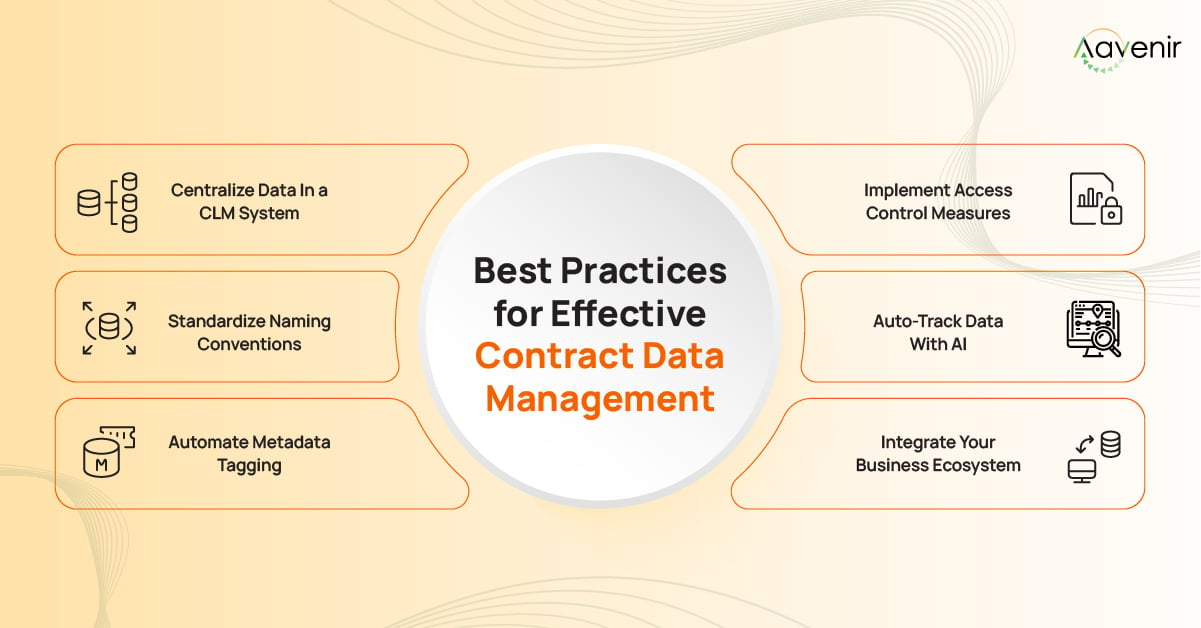
In this section, we’ll discuss six proven best practices you can apply today to organize, protect, and fully leverage your contract data for better business outcomes.
1. Centralize Data In a CLM System
Contract management software like Aavenir Contractflow offers a centralized space to create, review, negotiate, approve, store, track, and analyze contracts. This helps create a Single Source of Truth (SSOT) for analyzing contract data. With contract management software, legal and non-legal teams can easily find and use contract information from anywhere.
Take Control of Your Contract Data with Aavenir
Manage all your contracts, clauses, and compliance tasks in one intelligent platform built for visibility and control.
2. Standardize Naming Conventions
Without consistent naming rules, contracts are often difficult to organize. To avoid disorganization, create a standard naming convention for contracts, folders, and data fields. For example, you can use a format like Vendor Name – Contract Type – Start Date.
This step ensures that everyone in your organization can quickly locate and recognize contracts, leading to fewer errors and better collaboration across teams.
3. Automate Metadata Tagging
Manually tagging contract data is time-consuming and prone to errors. By using AI-powered tools, you can automate metadata tagging right when a new contract is executed.
Automation helps extract important details accurately. With this, you can easily search, filter, and report on contracts later. This not only saves time but also improves the quality and consistency of your contract database.
4. Implement Access Control Measures
Not everyone in the company needs access to every contract. Sensitive contracts, such as vendor agreements or financial documents, should be protected carefully.
Implement role-based access controls to ensure that only authorized users can view, edit, or approve specific contracts. Regularly review access permissions to keep your data secure and comply with internal policies and regulatory requirements.
5. Auto-Track Data With AI
It’s easy to miss renewal dates, compliance deadlines, or essential milestones when relying on manual tracking. That’s where AI can help. Use AI features within your contract management system to automatically track key contract data points and send alerts when action is needed.
Solutions like Aavenir Contractflow can help you auto-track obligations with AI. This proactive approach helps teams stay on top of obligations, avoid penalties, and manage contracts more efficiently without constant manual oversight.
6. Integrate Your Business Ecosystem
Contract data is critical for finance, sales, procurement, and legal processes. To maximize contract value, integrate your CLM system with your ERP, CRM, procurement, and finance platforms.
This ensures that important contract information, such as payment terms or renewal dates, flows automatically into the right business systems. Integration reduces data duplication, speeds up contract management workflows, and helps your organization operate with better coordination and accuracy.
These best practices show why a CLM platform is essential. Now, let’s explore how it helps manage contract data more effectively.
Why Use CLM Software to Manage Contract Data Automatically
Managing contract data manually slows teams down, increases the chance of errors, and makes it harder to stay compliant. CLM (Contract Lifecycle Management) software solves these problems by automating every step, from capturing contract details to tracking renewals and obligations.
With automation, you speed up contract management processes. Contracts move faster from creation to approval because key data, such as contract type, deal value, and risk indicators, are captured upfront and used to trigger the right workflows. No more email chains or manual routing.
Here’s how you can use a contract data management system to automate information tracking and management:
How to Leverage Contract Data With Automation
- Capture Smart Intake Data to Trigger Workflows
Use dynamic intake forms to collect key contract details and automatically send contracts into the correct review and approval path.
- Automate Approvals to Boost Compliance and Speed
Set up workflow automation that ensures every contract passes through required checks, reducing bottlenecks and human errors.
- Auto-Assign Post-Signature Tasks to the Right Teams
Automatically track obligations, milestones, and renewal dates after signing, making it easy for teams to stay proactive.
- Use AI and Dashboards for Real-Time Contract Insights
Leverage AI to extract contract data and dashboards to monitor contract health, risks, and upcoming actions at a glance.
Realize the Full Value of Contract Data With Aavenir
From intake to execution, Aavenir automates the way you handle contract data—boosting accuracy, compliance, and performance across teams.
Switch to Aavenir for Smart, Automated Contract Data Management
Aavenir Contractflow is built to simplify and automate contract data management across every stage. It starts with AI-powered data extraction that captures key terms, clauses, and dates from your contracts. From there, dynamic and customizable workflows route contracts through the right review and approval steps based on type, value, or risk.
Once approved, Aavenir integrates with eSignature tools to complete the signing process seamlessly. Post-signature, critical data like obligations, payment terms, and milestones are automatically shared with the right teams, ensuring timely execution and compliance.
With Aavenir Contractflow, you can:
- Get 5X better visibility over contract data
- Improve contracting cycle time by 80%
- Save 30% on contract management costs
- Reduce contractual risks by 5X
Whether you’re handling vendor agreements in procurement or customer contracts in sales, Aavenir helps you manage contract data with speed, accuracy, and full compliance. Book a demo to see how Aavenir can transform your contract data management.
Frequently Asked Questions on Contract Data Management
-
How does poor contract data management impact businesses?
Poor contract data management leads to missed renewals, delayed approvals, compliance risks, and revenue leakage. Without accurate, accessible data, businesses struggle to enforce obligations, track performance, and make informed decisions, resulting in operational inefficiencies and potential legal exposure.
-
How is contract data extracted from existing contracts?
Contract data is typically extracted using AI-powered tools within CLM software. These tools use OCR (Optical Character Recognition) and AI (Artificial Intelligence) to scan contracts, identify key fields (like names, dates, clauses, and obligations), and automatically tag them as structured data. This reduces manual effort and improves accuracy across the entire contract portfolio.
-
Can contract data management improve audit readiness?
Yes. With centralized, well-organized contract data, businesses can quickly generate reports, track obligation fulfillment, and provide evidence of compliance. This simplifies audit preparation, helping contract managers respond to audit requests faster and with more confidence.
-
Is contract data management only relevant for large enterprises?
No. Any organization that manages multiple contracts—regardless of size—can benefit from contract data management. For growing businesses, it helps scale contract management processes efficiently; for small teams, it reduces manual tracking and minimizes risk.


